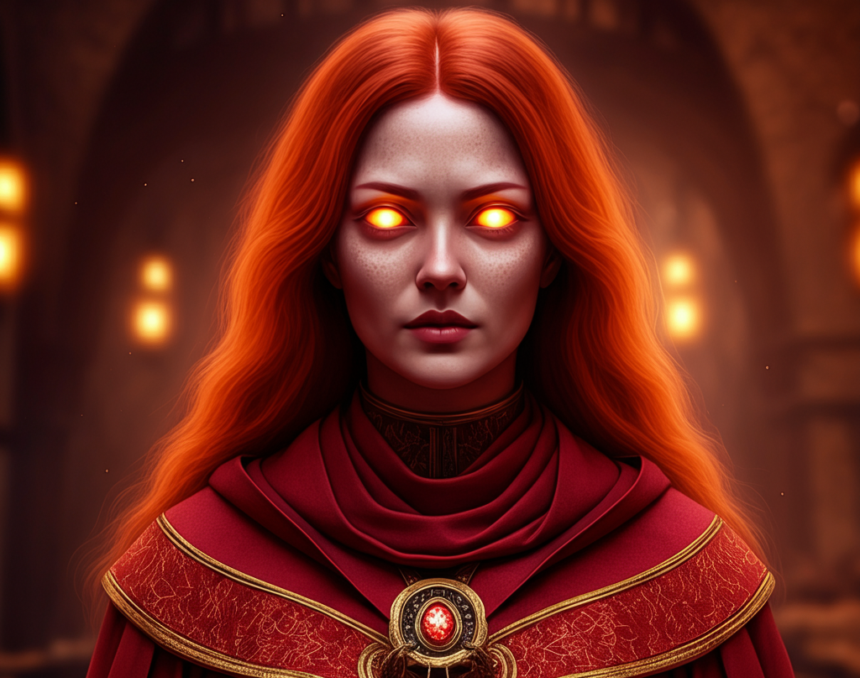Introduction to Melisandre from Game of Thrones
When you think of Game of Thrones, a myriad of characters comes to mind. Yet, few are as enigmatic and spellbinding as Melisandre. Known for her captivating red attire and the mysterious aura that surrounds her, this priestess of R’hllor has left an indelible mark on the series. With powers that challenge reality and decisions that spark outrage among fans, Melisandre is not just a secondary character; she’s a complex figure woven deeply into the fabric of Westeros’ tumultuous narrative. What drives her actions? And how do they ripple through the fates of others? Join us as we delve deeper into Melisandre’s world—a journey filled with magic, controversy, and unexpected twists.
Her role in the series and her impact on the story
Melisandre, often referred to as the Red Woman, plays a pivotal role in Game of Thrones. Her unwavering belief in the Lord of Light drives many key events throughout the series.
She serves as advisor and confidante to Stannis Baratheon initially, influencing his decisions with her prophetic visions. This connection alters the course of battles and alliances, highlighting her strategic importance.
Her presence also introduces themes of faith versus skepticism. Characters grapple with belief in magic and prophecy because of Melisandre’s actions and predictions.
Moreover, she acts as a catalyst for significant plot twists—most notably through her controversial resurrection of Jon Snow. This act transcends mere character development; it reshapes the entire narrative landscape.
Throughout various arcs, Melisandre embodies moral ambiguity. Her intentions remain elusive, leaving viewers questioning whether she is a savior or a manipulator at heart.
The significance of her red attire and necklace
Melisandre’s striking red attire is more than just a fashion statement. It symbolizes her connection to fire and the Lord of Light, showcasing her role as a priestess. The vivid hue captures attention and evokes both allure and danger.
Her necklace, an intricate piece adorned with a glowing red stone, holds profound significance. It’s not merely jewelry; it serves as the source of her power. Without it, Melisandre’s abilities are diminished. This duality reflects her character—both enchanting and formidable.
The color red also foreshadows bloodshed and sacrifice throughout the series. Her presence often heralds pivotal moments that alter the course of events in Westeros. Through this visual storytelling, viewers glean deeper insights into Melisandre’s motivations and beliefs without uttering a word.
Melisandre’s powers and abilities
Melisandre, the enigmatic Red Woman of Game of Thrones, wields formidable powers that often blur the lines between reality and illusion. Her connection to fire is not just theatrical; it allows her to perform extraordinary feats. She can ignite flames with a mere gesture, captivating onlookers and striking fear into enemies.
Her most haunting ability lies in her prophetic visions. Through the shadows and smoke, she glimpses potential futures, though they are shrouded in ambiguity. This foresight drives many of her decisions throughout the series.
Moreover, Melisandre’s use of blood magic adds another layer to her abilities. The infamous ritual involving Gendry showcases how she harnesses life force for dark purposes. Each act reveals both her power and moral complexity—forcing viewers to reconsider what makes someone truly heroic or villainous in Westeros’ brutal landscape.
Controversial moments and decisions made by Melisandre
Melisandre’s choices often sparked heated debates among fans. One of her most contentious actions was the sacrifice of Stannis Baratheon’s daughter, Princess Shireen. This act left viewers grappling with the morality behind her unwavering faith in the Lord of Light.
Another divisive moment came when she resurrected Jon Snow. While many celebrated his return, it raised questions about Melisandre’s true motives and the consequences of meddling with life and death.
Her decision to abandon Daenerys Targaryen after believing she was no longer important also stirred controversy. Was this a tactical retreat or an indication of her flawed judgment?
These moments highlight how complex Melisandre is as a character. Her bold decisions often teetered on the brink of righteousness and villainy, leaving audiences both fascinated and frustrated by her unpredictability.
Analysis of Melisandre’s character development throughout the series
Melisandre’s character arc is a fascinating journey through the duality of light and darkness. Initially, she appears as a staunch devotee of R’hllor, using her powers to manipulate events for what she believes to be the greater good.
As the series progresses, her actions reveal layers of complexity. Her unwavering faith leads to moments of moral ambiguity that challenge viewers’ perceptions. The burning of Shireen Baratheon starkly contrasts with her earlier benevolence and leaves fans divided.
Her encounters with key characters like Jon Snow and Stannis Baratheon further shape her evolution. With each interaction, we see glimpses of doubt creeping into her confidence. Melisandre transforms from a singularly focused sorceress into a figure grappling with the consequences of fate versus free will.
By the end, she stands at an intersection between redemption and regret—a testament to how power can both illuminate paths and cast dark shadows on one’s soul.
Fan theories surrounding Melisandre’s true intentions and identity
Melisandre’s enigmatic character has sparked numerous fan theories over the years. Some believe she is a secret Targaryen, which could explain her obsession with fire and dragons. This theory draws parallels between her powers and those of Daenerys.
Others speculate that Melisandre might be centuries old due to her ability to use magic effectively. Her age remains ambiguous, leading fans to wonder if she possesses knowledge from past lives.
Another captivating theory revolves around the idea that Melisandre has been manipulating events for personal gain rather than serving the greater good. Fans point to her willingness to sacrifice others as evidence of a darker agenda.
Her true intentions remain elusive, making each new episode an opportunity for fresh speculation among dedicated viewers eager to uncover the mysteries shrouding this complex sorceress.
Conclusion: The lasting impact of Melisandre on Game of Thrones
Melisandre is a character who left an indelible mark on the world of Game of Thrones. Her journey from a mysterious priestess to a pivotal player in the battle for Westeros showcases the complexity of her motivations and beliefs. The duality of her actions—often driven by an unyielding faith—adds layers to her role within the larger narrative.
Her striking red attire and iconic necklace serve not only as physical attributes but also symbolize deeper themes such as power, seduction, and sacrifice. Melisandre’s powers astounded viewers, challenging their perceptions of magic within the series.
The controversies surrounding her choices sparked debates among fans about morality and consequence in times of war. As she evolves through different seasons, we witness both vulnerability and fortitude that make her relatable yet enigmatic.
Fan theories continue to swirl around Melisandre’s true intentions. Many speculate if she was more than just a devoted servant to R’hllor or whether she had personal stakes influencing major events.
Melisandre encapsulates the essence of Game of Thrones: ambiguous morality intertwined with characters who are never purely good or evil. Her influence reverberates throughout the series long after credits roll, making discussions about her legacy all the more intriguing for fans old and new alike.











